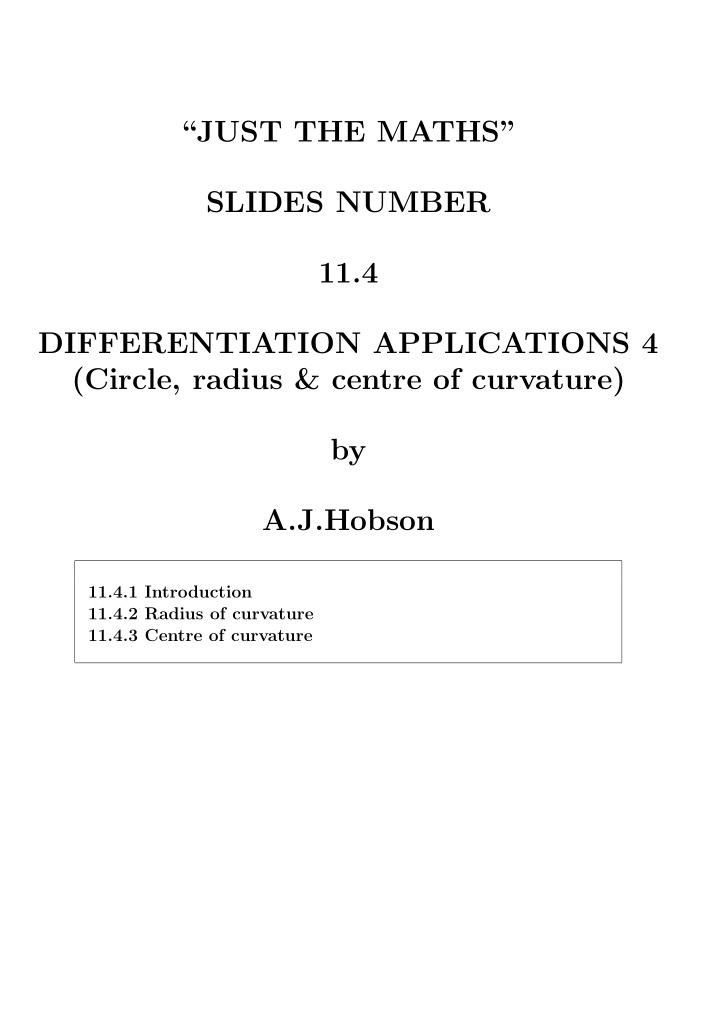



“JUST THE MATHS” SLIDES NUMBER 11.4 DIFFERENTIATION APPLICATIONS 4 (Circle, radius & centre of curvature) by A.J.Hobson 11.4.1 Introduction 11.4.2 Radius of curvature 11.4.3 Centre of curvature
UNIT 11.4 DIFFERENTIATION APPLICATIONS 4 CIRCLE, RADIUS AND CENTRE OF CURVATURE 11.4.1 INTRODUCTION At a point, P, on a given curve, let a circle be drawn which just touches the curve and has the same value of the curvature (including its sign). y ✻ C ❅ ρ ❅ ❅ P ✲ x O This circle is called the “circle of curvature at P” . Its radius, ρ , is called the “radius of curvature at P” . Its centre is called the “centre of curvature at P” . 1
11.4.2 RADIUS OF CURVATURE If the curvature at P is κ , then ρ = 1 κ . Hence, ρ = d s d θ. In cartesian co-ordinates, 3 � 2 2 � d y 1 + d x ρ = . d 2 y d x 2 Note: For curves with negative curvature, the length of the ra- dius of curvature is the numerical value obtained in the above formula. Later, it will be necessary to use the appropriate sign for the radius of curvature. EXAMPLE Calculate the radius of curvature at the point (0 . 5 , − 1) of the curve whose equation is y 2 = 2 x. 2
Solution Differentiating implicitly, 2 y d y d x = 2 . That is, d y d x = 1 y. Also, d 2 y d x 2 = − 1 y 2 . d y d x = − 1 y 3 . Hence, at the point (0 . 5 , − 1), d x = − 1 and d 2 y d y d x 2 = 1 . We conclude that 3 ρ = (1 + 1) √ 2 = 2 2 . 1 3
11.4.3 CENTRE OF CURVATURE Consider a point, ( x 0 , y 0 ), on an arc of a curve y = f ( x ) for which the curvature is positive, the arc lying in the first quadrant. It may be shown that the formulae obtained for the co- ordinates, ( x c , y c ), of the centre of curvature apply in any situation, provided that the curvature is associated with its appropriate sign. C( x c , y c ) ❅ ρ � ❅ θ � y ❅ � ✻ ❅ ❅ � P( x 0 , y 0 ) � θ � � θ � ✲ x O � � � � � � � From the diagram, x c = x 0 − ρ sin θ, y c = y 0 + ρ cos θ. 4
Note: It is a good idea to sketch the curve in order estimate, roughly, where the centre of curvature is going to be. This is especially important where there is uncertainty about the precise value of the angle, θ . EXAMPLE Determine the centre of curvature at the point (0 . 5 , − 1) of the curve whose equation is y 2 = 2 x. Solution From the earlier example on calculating radius of curva- ture, y and d 2 y d y d x = 1 d x 2 = − 1 y 3 , giving d x = − 1 d 2 y d y √ d x 2 = 1 and ρ = 2 2 at the point (0 . 5 , − 1). 5
y ✻ C ✁ ✲ x ✁ ❍❍❍❍❍❍❍❍❍❍❍ O θ ✁ ✁ ✁ ✁ ❍ The diagram shows that the co-ordinates, ( x c , y c ), of the centre of curvature will be such that x c > 0 . 5 and y c > − 1. This will be so provided that the angle, θ , is a negative acute angle; (that is, its cosine will be positive and its sine will be negative). In fact, θ = tan − 1 ( − 1) = − 45 ◦ . Hence, √ x c = 0 . 5 − 2 2 sin( − 45 ◦ ) , √ y c = − 1 + 2 2 cos( − 45 ◦ ) . That is , x c = 2 . 5 and y c = 1 . 6
Recommend
More recommend